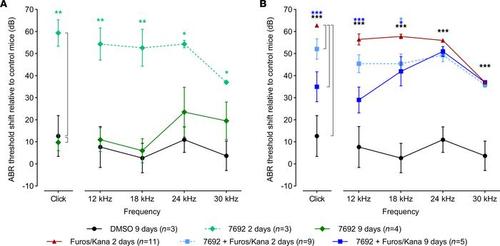Fig. 12
- ID
- ZDB-FIG-210504-12
- Publication
- Kenyon et al., 2021 - Identification of a novel series of hair-cell MET channel blockers that protect against aminoglycoside-induced ototoxicity
- Other Figures
- All Figure Page
- Back to All Figure Page
|
Transtympanic injection of UoS-7692 reduces kanamycin-induced hearing loss in mice. (A) ABR thresholds shifts from baseline (0 dB) measured 9 days after bilateral trans-tympanic injection (BTTI) of 5% DMSO (black circles, black line), 2 days after BTTI of 50 mM UoS-7692 (light-green diamonds, dashed line), and 9 days after BTTI of 50 mM UoS-7692 (dark-green diamonds, solid line). UoS-7692 induced significant temporary threshold shifts at 2 days, which were resolved by 9 days (1-way ANOVAs for click and individual pure-tone frequencies with Dunnett’s multiple-comparison test between UoS-7692 at 2 and 9 days and DMSO at 9 days). Significance levels for differences between UoS-7692 at 2 days and DMSO at 9 days are indicated by light-green asterisks. (B) ABR threshold shifts measured 9 days after BTTI of 5% DMSO (black circles), 2 days (light-blue squares, dashed line), 9 days (dark-blue squares, solid line) after 50 mM UoS-7692 BTTI followed by furosemide/kanamycin exposure, and 2 days after furosemide/kanamycin exposure without BTTI (red triangles). BTTI of UoS-7692 significantly reduced threshold shifts 9 days after furosemide/kanamycin exposure for clicks and pure-tone frequencies of 12 and 18 kHz (1-way ANOVAs for click and individual pure-tone frequencies with Dunnett’s multiple-comparison test between the 2-day furosemide/kanamycin condition and the other 3 conditions). Significance levels for differences between Furos/Kana at 2 days and UoS-7692 + Furos/Kana at 2 and 9 days are indicated by light- and dark-blue asterisks, respectively; significance levels for differences between Furos/Kana at 2 days and DMSO at 9 days are indicated by black asterisks. *P < 0.05; **P < 0.01; ***P < 0.001. N numbers are shown in the key. Error bars show SEM. |

